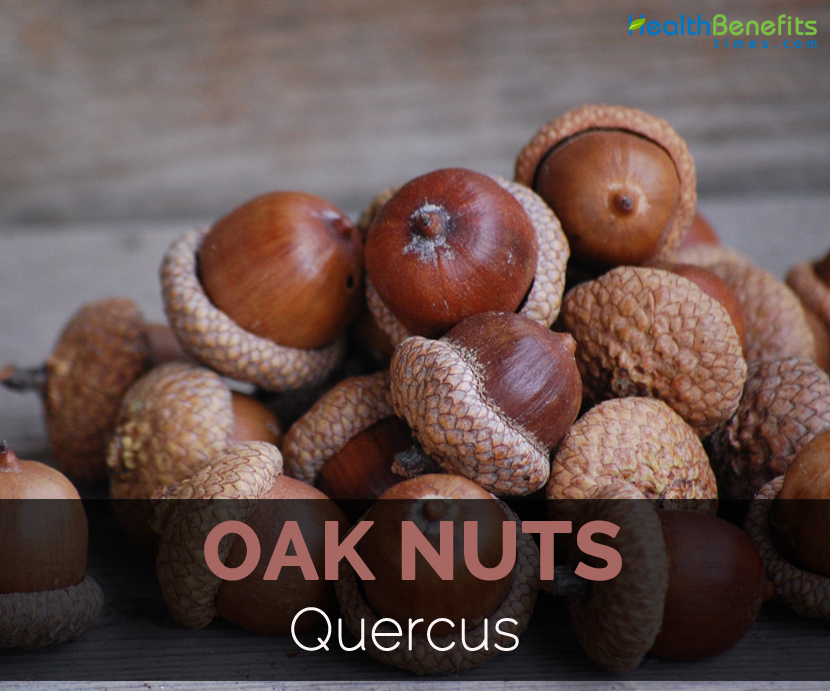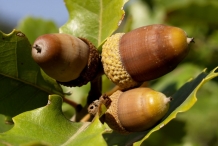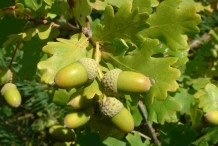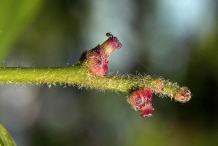It is an evergreen or deciduous tree or shrub which measures about 70 feet in height and 9 feet wide. The branches of the tree measures 135 feet long. The leaves are simple, alternate and arranged spirally. The flowers are monoecious, yellow to green and about 1-3 inches long which are found during mid-spring. The tree produces nuts whose color ranges from green, brown to yellow. The nuts are round to tapered and 1/2-1 1/2 inches long. The seeds are usually one but could be two or three rarely with tough and leathery shell that are a cup shaped cupule.
History
It is found in deciduous and evergreen species that extends from cool temperate to tropical latitudes in Europe, Americas, Asia and North Africa. The large number of Oak species is found in North America. United States have 90 species, Mexico has 160 species but 109 are endemic. China is the second highest in oak diversity containing about 100 species.
The oak was considered as a sacred tree mostly to Druids. Besides the medicinal use of bark, it was used to tan leather and adds flavor to the smoked fish. Formerly, Oak lumber was used for building naval fleets of the European nations. Since the Aztec empire time, it was used as an aid for diarrhea. Acorns were used as a staple food for Native Americans as well as for the wild animals during winter.
Nutritional value
28.35 grams of Oak nuts (raw) provides 110 calories, 7.91 g of moisture, 1.74 g of protein, 6.76 g of total fat, 0.38 g of ash and 11.55 g of carbohydrate. It provides 19.56% of copper, 19.31% of total fat, 16.48% of manganese, 11.54% of vitamin B6, 8.88% of carbohydrate, 6.25% of folate, 4.84% of isoleucine, 4.77% of tryptophan, 4.64% of valine, 4.29% of magnesium and 4.06% of vitamin B5.
Health Benefits of Oak nuts
In early cultures, acorns were used as a vital dietary food. Acorns are widely used in various dishes by the Native Americans and Koreans. Acorns have high amount of tannins due to which it tastes bitter and unpleasant. It is used as a perfect substitute for coffee. Acorns could be made into flour and baked as muffins and breads. It is rich in carbohydrate, fat, vitamins and minerals.
- Healthy skin
Acorns have astringent properties that help to protect skin for which the tannins should be leached out from the acorns. The nuts should be boiled or soaked in water after that the water rich in tannin should be applied topically to the skin that helps to ease rashes, burns, speeds up the healing process of wounds and cuts, lower inflammation as well as burns. The topical application of this water helps to cure pains and aches. (1)
- Assist digestion
Acorns have high amount of fiber that helps to enhance the digestion health. Fiber assists in the regulation of bowel movements and treats diarrhea and constipation. It is helpful for the people with cramps, irregular bowel movements, bloating and gastrointestinal distress. (2)
- Prevents diabetes
Acorns help to regulate the level of sugar, prevent harmful spikes as well as plunges of glucose that results in diabetes and also treats it. It is possible due to the presence of complex carbohydrates and fiber content. (3)
- Healthy heart
Acorns are the best choice for those who want to reduce the fat content in the body. It contains five times more unsaturated fat in comparison to the saturated fats that helps to enhance the total balance of cholesterol and also prevents atherosclerosis, obesity and harmful conditions. (4)
- Level of energy
Acorns have high amount of complex carbohydrates that provides the energy that are long lasting. The nuts and flour are better than simple sugars of empty carbohydrates that provides energy of short bursts. (5)
- Healthy bones
Acorns have minerals such as potassium, calcium, phosphorus that helps to enhance the health of bones and also prevents the chances of osteoporosis. Calcium is the vital minerals that is essential for the mineral density of bones and is found in adequate amounts. (6)
- Metabolic activities
The oak nuts are small in size but loaded with vitamin B such as thiamin, niacin, vitamin B12 and riboflavin. The intake of acorns helps to regulate the processes of enzymes which is essential for the health. (7)
- Assist healing
Acorns are rich in protein content which is vital for the production of new cells and tissues and also repairs the damaged areas by speed up the healing process caused due to illness or injuries. (8)
Traditional uses
- It possesses an anti-inflammatory, astringent, decongestant, antiseptic, tonic and haemostatic properties.
- A decoction made from bark helps to treat chronic diarrhea, dysentery, haemorrhages, intermittent fevers, etc.
- It is used externally to bathe wounds, sweaty feet, skin eruptions, piles, etc.
- It is used as a vaginal douche for the genital inflammations and wash for mouth and throat infections.
- The galls are used to treat haemorrhage, dysentery, chronic diarrhea, etc.
- It is used to treat of spleen and gall bladder disorders.
- It is also used to treat diarrhea, rectal bleeding and dysentery.
- It helps to treat inflammatory skin problems such as chilblains and frostbite.
- Oak is used in ayurvedic medicine to treat bronchitis to hemorrhaging, fever, gonorrhea, diabetes and tonisillitis.
- The bark is used to treat chronic diarrhea, mucous discharge and dysentery as well as lung catarrh.
- An infusion helps to treat external and internal hemorrhages, stomach, liver inflammation and tuberculosis.
- It is also applied to nappy rash, burns, skin irritations, chilblains, weeping eczema, insect bites, contact dermatitis and sweaty feet.
- The leaves are diuretic and help to strengthen stomach.
Precautions
- The acorns and leaves of the Oak tree are harmful due to high amount of toxin tannic acid that could damage kidneys and gastroenteritis.
- The symptoms of poisoning are depression, lack of appetite, diarrhea, constipation, colic and blood in urine.
- After extracting tannins, acorns could be consumed.
How to Eat
- Acorns are consumed as a food source.
- Japanese and Ancient Greek eat acorns during famine.
- In Ancient Iberia, it was considered as staple food.
- Acorn meals are used in some recipes.
- In Korea, jelly is made from acorns and Korean noodles are made from starch or acorn flour.
- The seeds are roasted and chopped and roasted which is used as a substitute for almond.
- The dried ones are used to thicken stews and combined with cereals to make bread.
- The roasted seeds are used as a substitute for coffee.
Other Facts
- The biggest tree of Oaks is found in Goose Island State Park which is about 45 feet tall and 35 feet wide with a crown having 90 feet as diameter.
- It absorbs 50 gallons of water per day.
- Female flowers are smaller than male.
- Acorns are produced at the age of 20-50 years.
- The animals such as pigeons, pigs, duck, deer, mice and squirrels consume acorns.
- Oak is the national plant of USA, France, England, Poland, Germany, Latvia and Serbia and it represents endurance and strength.
- The species of Oaks lives for over 200 years but some certain trees exists for more than thousand years.
- A mature tree produces 2200 acorns in a year.
- The white oak is regarded as one of the tallest species of oak.
- The tallest White oak known till now is about 144 feet (44 meters) in height.
References:
https://en.wikipedia.org/wiki/Oak
https://en.wikipedia.org/wiki/Acorn
http://davesgarden.com/guides/pf/go/62918/
https://npgsweb.ars-grin.gov/gringlobal/taxonomydetail.aspx?id=104673
http://www.pfaf.org/user/Plant.aspx?LatinName=Quercus+robur
http://www.botanical.com/botanical/mgmh/o/oakcom01.html
http://www.cloverleaffarmherbs.com/oak/
http://www.sacredearth.com/ethnobotany/plantprofiles/oak.php
http://www.softschools.com/facts/plants/oak_tree_facts/505/
http://justfunfacts.com/interesting-facts-about-oak-trees/
Comments
comments
| Oak Nuts Quick Facts | |
|---|---|
| Name: | Oak Nuts |
| Scientific Name: | Quercus |
| Origin | Northern Hemisphere |
| Colors | Green, brown, yellow (Fruit) |
| Shapes | Length: 1/2-1 1/2 inches; Round-tapered (Fruit) |
| Taste | Bland or bitter |
| Calories | 110 Kcal./cup |
| Major nutrients | Copper (19.56%) Total Fat (19.31%) Manganese (16.48%) Vitamin B6 (11.54%) Carbohydrate (8.88%) |
| Health benefits | Healthy skin, Assist digestion, Prevents diabete, Healthy heart, Level of energy |
| More facts about Oak Nuts | |



